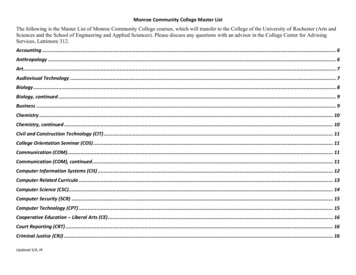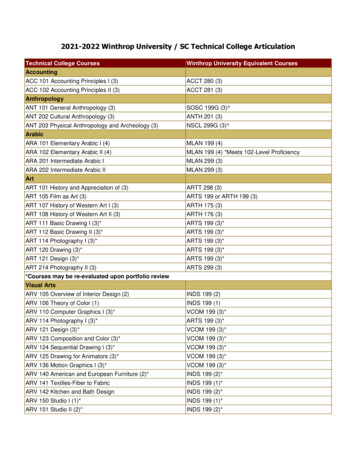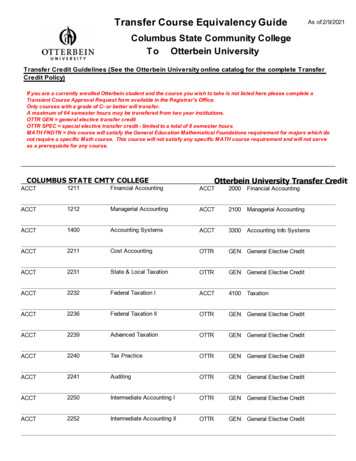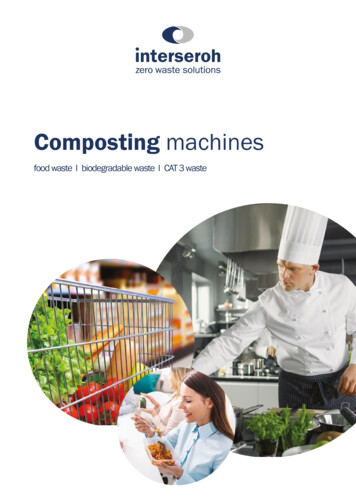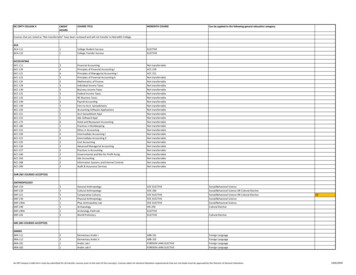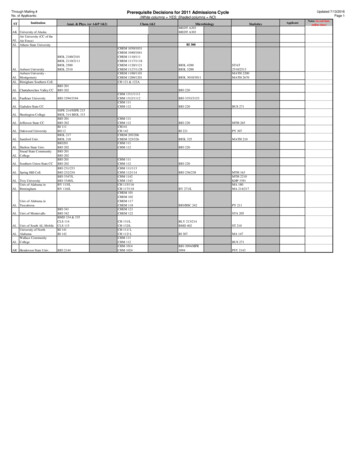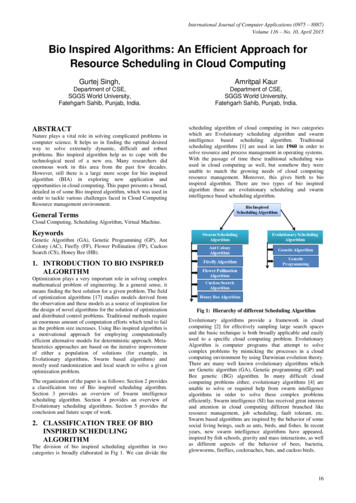
Transcription
International Journal of Computer Applications (0975 – 8887)Volume 116 – No. 10, April 2015Bio Inspired Algorithms: An Efficient Approach forResource Scheduling in Cloud ComputingGurtej Singh,Amritpal KaurDepartment of CSE,SGGS World University,Fatehgarh Sahib, Punjab, India.Department of CSE,SGGS World University,Fatehgarh Sahib, Punjab, India.ABSTRACTNature plays a vital role in solving complicated problems incomputer science. It helps us in finding the optimal desiredway to solve extremely dynamic, difficult and robustproblems. Bio inspired algorithm help us to cope with thetechnological need of a new era. Many researchers didenormous work in this area from the past few decades.However, still there is a large more scope for bio inspiredalgorithm (BIA) in exploring new application andopportunities in cloud computing. This paper presents a broad,detailed in of some Bio inspired algorithm, which was used inorder to tackle various challenges faced in Cloud ComputingResource management environment.scheduling algorithm of cloud computing in two categorieswhich are Evolutionary scheduling algorithm and swarmintelligence based scheduling algorithm. Traditionalscheduling algorithms [1] are used in late 1960 in order tosolve resource and process management in operating systems.With the passage of time these traditional scheduling wasused in cloud computing as well, but somehow they wereunable to match the growing needs of cloud computingresource management. Moreover, this gives birth to bioinspired algorithm. There are two types of bio inspiredalgorithm these are evolutionary scheduling and swarmintelligence based scheduling algorithm.General TermsCloud Computing, Scheduling Algorithm, Virtual Machine.KeywordsGenetic Algorithm (GA), Genetic Programming (GP), AntColony (AC), Firefly (FF), Flower Pollination (FP), CuckooSearch (CS), Honey Bee (HB).1. INTRODUCTION TO BIO INSPIREDALGORITHMOptimization plays a very important role in solving complexmathematical problem of engineering. In a general sense, itmeans finding the best solution for a given problem. The fieldof optimization algorithms [17] studies models derived fromthe observation and these models as a source of inspiration forthe design of novel algorithms for the solution of optimizationand distributed control problems. Traditional methods requirean enormous amount of computation efforts which tend to failas the problem size increases. Using Bio inspired algorithm isa motivational approach for employing computationallyefficient alternative models for deterministic approach. Metaheuristics approaches are based on the iterative improvementof either a population of solutions (for example, inEvolutionary algorithms, Swarm based algorithms) andmostly used randomization and local search to solve a givenoptimization problem.The organization of the paper is as follows: Section 2 providesa classification tree of Bio inspired scheduling algorithm.Section 3 provides an overview of Swarm intelligencescheduling algorithm. Section 4 provides an overview ofEvolutionary scheduling algorithms. Section 5 provides theconclusion and future scope of work.2. CLASSIFICATION TREE OF BIOINSPIRED SCHEDULINGALGORITHMThe division of bio inspired scheduling algorithm in twocategories is broadly elaborated in Fig 1. We can divide theFig 1: Hierarchy of different Scheduling AlgorithmEvolutionary algorithms provide a framework in cloudcomputing [2] for effectively sampling large search spacesand the basic technique is both broadly applicable and easilyused to a specific cloud computing problem. EvolutionaryAlgorithm is computer programs that attempt to solvecomplex problems by mimicking the processes in a cloudcomputing environment by using Darwinian evolution theory.There are many well known evolutionary algorithms whichare Genetic algorithm (GA), Genetic programming (GP) andBee genetic (BG) algorithm. In many difficult cloudcomputing problems either, evolutionary algorithms [4] areunable to solve or required help from swarm intelligencealgorithms in order to solve these complex problemsefficiently. Swarm intelligence (SI) has received great interestand attention in cloud computing different branched likeresource management, job scheduling, fault tolerant, etc.Swarm based algorithms are inspired by the behavior of somesocial living beings, such as ants, birds, and fishes. In recentyears, new swarm intelligence algorithms have appeared,inspired by fish schools, gravity and mass interactions, as wellas different aspects of the behavior of bees, bacteria,glowworms, fireflies, cockroaches, bats, and cuckoo birds.16
International Journal of Computer Applications (0975 – 8887)Volume 116 – No. 10, April 2015In the next section, we are going to discuss one by one eachSwarm intelligence scheduling algorithm used in a cloudcomputing environment in detail.computing resource management and job scheduling problem.This approach can be easily understood by analyzing thebelow listed simple ant colony algorithm.3. SWARM INTELLIGENCESCHEDULING ALGORITHMSwarm intelligence (SI) has received great interest andattention in the communities of optimization, computationalintelligence, and computer science, bio-inspired algorithmsespecially those Swarm intelligence based algorithms, hasbecome very popular in cloud computing environment. Infact, these nature-inspired Meta heuristic algorithms are nowamong the most widely used algorithms for optimization andcomputational intelligence in cloud computing systems.Swarm intelligence [6] based algorithms are inspired by thebehavior of some social living beings, such as ants, termites,birds, and fishes. In recent years, new swarm intelligencealgorithms have appeared, inspired by fish schools, gravityand mass interactions , as well as different aspects of thebehavior of bees, bacteria, glow-worms, fireflies,cockroaches, bats and cuckoo birds . Despite the swarminspiration common to these approaches, they have their ownparticular way to exploit and explore the search space of theproblem.In Swarm algorithm our main concentration is on theimplementation of these algorithms in order to solve complexcloud computing problems. Some most well known swarmbased algorithms used in cloud computing system arediscussed below in detail. These algorithms are being inspiredby the collective behavior of animals, exhibit decentralized,self-organized patterns in the foraging process.3.1 Ant Colony AlgorithmAnt colony algorithm [10] model had been derived from theobservation of real ant‟s behavior, and this model act as asource of inspiration in design of novel algorithms in order tofind the solution of optimization and distributed controlproblems in cloud computing environment. The main ideabehind the ant colony algorithm is self-organizing principleswhich allow the highly coordinated behavior of real ants andwhich can be exploited to coordinate populations of artificialagents and it help us in solving computational problems ofcloud computing environment.An important finding of the researcher about ant behavior isthat most of the communication among ants and theenvironment is based on the use of chemical produced by theants. This chemical is known as pheromones. Ants with thehelp of their smelling power are going to smell the pheromonechoose that path which has high pheromone concentrationIn the Fig 2(a) the bridge had two branches of equal length. Atthe start, ants (numbered by 1, 2, and 3) were left free to movebetween the starting point and the food source and theselection of one path out of two is chosen randomly. Whichwe can see clearly in Fig 2(b). While moving through thosetwo path ants had deposited the pheromones the percentage ofant‟s pheromones directly depends on the number of antsmoved over that path. Furthermore, all the three ants wentaway with the fraction of food (represented by OD in Fig2(c)). Ants has come back to the initial state this time ant‟shad chosen the path which had high pheromone density as thisprocess can be seen clearly in fig 2(d) and fig 2(e). At end, theants had moved away with the leftover food as well as alsoincrease the pheromone density from the path which they hadchosen. This whole algorithm can help us in solving the cloud3.1.1Simple Ant Colony AlgorithmStep1) Job arrived on the cloud server is inserted in the jobqueue. Pheromone count for all the virtual machine availableto cloud server is equated to zero.Step2) Jobs are moved to different resource pool queue RP[j]depending upon the characteristics mapping between theresource pool queue RP[j] and job selected by the schedulerfrom the job queue.Step3) For every single resource pool queue RP[j] a single antAN[j] is allocated.Step4) An ant AN[j] select the job from the resource poolqueue RP[j] and allocate the virtual machine VM[i] (wherei j) depending on the characteristics mapping between the joband the virtual machine and also depending on the pheromoneconcentration on the virtual machine.Step5) Job starts executing on the selected virtual machine.Step6) A pheromone is deposited at the virtual machine with17
International Journal of Computer Applications (0975 – 8887)Volume 116 – No. 10, April 2015the passage of time the amount of pheromone concentrationstart increasing with the help of a certain formula dependingon the no jobs arrived at a desired virtual machine.Step7) The concentration of pheromone also decreased on thevirtual machine with the help of same formula which we usedin order to increase the pheromone concentration.Step8) Go to step 4 until the last resource pool queueemptied.is3.2 Firefly AlgorithmsThe fire flies [5] are a amazing natural specie whichcoagulates and produces immense flash light. There arenumerous firefly species and each firefly species has a uniquepattern of flashes. The flashing light is produced by a processof bio luminescence.There are generally two functions of such flashes firstly inorder to attract the mating partner and to attract to potentialprey. There are numerous factors which bring both the sextogether those are rate of flashing, rhythmic flash and amountof time between flashes. The response of the female dependson the unique pattern generated by male specie. This naturalphenomenon can help us in solving a large amount ofcomplex cloud computing problem in scheduling andmanaging the resources. Depending on firefly [8] behaviorbelow listed simple algorithm shows how this naturalphenomenon can help us in managing resources in cloudcomputing environment.3.2.1pollination process there are only two major forms of thepollination process biotic and a-biotic pollination. In bioticpollination process, pollen grains are transferred bypollinator‟s insects and animals. In a-biotic pollinationprocess which does not require pollinator. In addition to itfind help in pollination of such plants flower (for e.g. Grass).This flower pollination [11] phenomenon can use in order tosolve many complex computational and distributed problemsof cloud computing environment. In addition to it also help usin solving scheduling, optimization and resource managementproblem of cloud computing system. The below listed, figureshows how the whole pollination process happens in thenatural environment.In fig 3(a) which clearly shows the different parts of the plantfor which a plant is composed of at the top of the plant we cansee the pollen grain. In addition to it, this is the part of theplant where the pollinator is going to sit and take pollensalong with him and these pollens act as an important part inthe pollination process.Simple Fire Flies AlgorithmStep1) Job arrived on the cloud server is inserted in the jobqueue. Define the light absorption coefficient for all thevirtual machine available to cloud server and initialize it tozero.Step2) Jobs are moved to different resource pool queue RP[j]depending upon the characteristics mapping between theresource pool queue RP[j] and job selected by the schedulerfrom the job queue.Step3) for every single resource pool queue RP[j] a singlefirefly FF[j] is allocated.Step4) A firefly FF[j] select the job from the resource poolqueue RP[j] and allocate the virtual machine VM[i] (wherei j) depending on the characteristics mapping between the joband the virtual machine and also depending on the lightabsorption coefficient value on the virtual machine.Step5) Job starts executing on the selected virtual machine.Step6) Light absorption coefficients value at the virtualmachine start increasing with the passage of time dependingon the number of jobs arrived at that virtual machine.Step7) Light absorption coefficients value of firefly decreasedon the virtual machine with the passage of time depending onthe number of jobs completed their execution at that virtualmachine.Step8) Go to step 4 until the last resource pool queueemptied.is3.3 Flower Pollination AlgorithmFlower pollination is a process which acts inside almost 80percent of the plant species on the earth. Flower pollination[9] is a process in which transfer of pollen grain plays animportant role and such transfer is taken care by pollinatorssuch as insects, birds, bats, other animals. Some flowers canonly attract a specific species of insect or bird for a successfulFig 3 (a): Pollen grains of plants [15]This natural phenomenon can help us in solving a largeamount of complex cloud computing problem in schedulingand managing the resources. Depending on the flowerpollinator behavior a below listed simple algorithm showshow this natural phenomenon can help us in managingresources in a cloud computing environment.3.3.1Simple Flower Pollination AlgorithmStep1) all submitted job reside in the job queue of cloudserver. Calculate the queue depth or length and assign itsvalue to variable called queue length (QL).Step2) Generate the initial bee required by applying a randomfunction on the queue length (QL) and assign its value tovariable bee required(BR).Step3) for each bee generated extracts job from the job queueof cloud server and assign the job to the virtual machine. Startexecuting job.Step4) Go to step1 until the job queue is emptied.3.4 Cuckoo Search (CS)The Cuckoo search [3] was inspired from a naturalphenomenon in which there is cuckoo specie which lay eggsin the nest of host birds. In addition to it there are somefemale cuckoos which change the color and patterns of thehost birds. This mechanism helps in bluffing the host bird ofthe cuckoo bird. But sometimes host birds the eggs are nottheir own and they will throw their whole nest and startbuilding a new one at a different place. The cuckoo eggs hatcha little earlier than the host eggs. Once the first cuckoo chickis hatched his first instinct action is to evict the host eggs byblindly. Propelling the eggs out of the nest. This action resultsin increasing the cuckoo chick‟s share of food provided by itshost bird.18
International Journal of Computer Applications (0975 – 8887)Volume 116 – No. 10, April 2015This natural phenomenon can be used in order to solve a largenumber of complex cloud computing problems in schedulingand managing the resources. Depending on the cuckoo search[13] the below listed simple algorithm shows how this naturalphenomenon can help us in managing resources in cloudcomputing environment.3.5.23.4.13.5.3Simple Cuckoo Search AlgorithmStep1) Job arrived on the cloud server is inserted in the jobqueue.Step2) Jobs are moved to different resource pool queue RP[j]depending upon the characteristics mapping between theresource pool queue RP[j] and job selected by the cuckooscheduler from the job queue.Tremble DanceScout bee performs this dance from ages in order to recruitmore honey bees to collect nectar from the food source. Thisdance is performed on the dance floor in order tocommunicate a long delay in unloading the nectar or shortageof receiver bees.Simple Honey Bee AlgorithmStep1) all submitted job resides in the job queue of cloudserver. Calculate the queue depth or length and assign itsvalue to variable called queue length (QL).Step2) If the queue length is greater than zero than bee isgoing to perform a waggle dance at the job queue hive.Step3) for every single resource pool queue RP[j] a singlehost bird HB[j] is allocated.Step3) Generate the initial bee required by applying a randomfunction on the queue length (QL) and assign its value tovariable bee required(BR).Step4) host birds HB[j] select the job from the resource poolqueue RP[j] and allocate the virtual machine VM[i] (wherei j) depending on the characteristics mapping between the joband the virtual machine.Step3) for each bee generated extracts job from the job queueof cloud server and assign the job to the virtual machines.Start executing job.Step5) Job starts executing on the selected virtual machine.Step6) Go to step 4 until the last resource pool queue isemptied.3.5 Honey Bee AlgorithmHoney bee [7] travel over long distances and simultaneouslyin multiple directions in search of food sources. Flower withlarge amount of pollen receives a large amount of honey beesin comparison with the flower which has a less amount ofpollen. Scout bees begin their search in order to find forpromising flower patches. Scout bees move randomly fromone patch to another. When scout bee return to the hive andthose scout bees which had found a patch greater than athreshold deposit their pollen and a waggle dance isperformed on the dance floor by a bee. While extracting thefood from the hive bee monitors the food level of the patch.This is very crucial thing as the next waggle dances performedby the bee depend on the current amount food available in thehive to a large extent. Furthermore, if the patch is still rich infood source than a waggle dance is performed by the bee onthe dance floor and more bees will be recruited to that source.Scout bee main purpose is to discover a new food sourcewhich employed bees were unable to find.In cloud computing, we can usually implement this algorithmwhile dealing with job fault tolerant. Apart from thisalgorithm also help us in dealing with difficult cloudcomputing problems. These bees perform their operation byfollowing the random search approach. There are differenttypes of dance performed by Scout Bee which are listedbelow:3.5.1Step4) Go to step1 until the job queue is emptied.In this section, we had discussed the Swarm schedulingalgorithm used in cloud computing environment in detailed.Evolutionary scheduling algorithms were unable to meet theneeds of cloud computing complex problems. Evolutionaryalgorithm seeks help from swarm intelligence algorithms inorder to solve these complex problems efficiently. In nextsection we are going to discuss evolutionary schedulingalgorithm one by one.4. EVOLUTIONARY SCHEDULINGALGORITHMEvolutionary Algorithm [12] is a term which can be definedwith the help of natural mechanisms of selection andevolution. This term is mainly divided into three subcategories evolutionary strategies, genetic algorithm andgenetic programming.4.1 Genetic algorithmIn genetic algorithm [18], mainly we use the four terms whichare selection, crossover population and mutation. In thisalgorithm, we use a long binary string instead of usingadvanced data structures like trees or graphs in order toimplement this algorithm in cloud computing. In geneticalgorithm, we used Charles Darwin‟s theory (“survival of thefittest”) of biological evolution in natural science. There arethree operators [16] used in the genetic algorithm these area)Crossoverb)Mutationc)Selection of the fittest.Waggle DanceScout bees to communicate information about food source tothe rest of the colony perform this dance on the dance floor.Scout bees provide the following information by means ofwaggle dance .a)Quality of food source.b)Distance of the food source from the hive.c)Direction of the food source.Fig 4(a): Genetic Algorithm Operation19
International Journal of Computer Applications (0975 – 8887)Volume 116 – No. 10, April 2015There are three main genetic operators used in order toimplement this algorithm in cloud computing system which iscrossover, mutation, and selection.a)b)c)Crossover: It is a process in which we are going to findan index location among chromosomes long binarystrings from that location we are going to perform thenext operation called mutation in cloud computingenvironment. For example, in Fig 4(a) we can see thatthe male chromosomes index number are 3 (0 to 3) andfor a female chromosome index number are 4 (4 to 6).Both of these two index show a virtual boundary in twochromosomes from the crossover operation is going to beexecuted.Mutation: It is processes in which we randomly selectthe parts of one chromosome (male or female) this helpus in increasing the diversity of the population. Forexample in fig 4(a) Male chromosome dominate femalechromosomes from characteristics index 0 to 3 andfemale chromosomes dominate male chromosomes fromcharacteristics index 4 to 6 as a result of the mutationoperation is performed on this dominating characteristicsthis give rise to child's chromosomes.Selection of the fittest: It is a process in which selectsthe chromosomes with high fitness factor and we passthese chromosomes to the next generation. This wholeprocess will help us in reaching the best chromosomes inthe near future. For example in fig 4(a) we can say thatthe child chromosome is better in each and every sensethan male or female chromosomes.In this algorithm character strings are represented by an arrayof bits in order to represent the chromosomes. On this set ofchromosomes we perform operations like crossover, mutationand selection of the fittest. Our aim in this is to reach achromosome, which is optimal. In genetic algorithm [12], weselect or create an initial random population of size „X‟ andevery single element of this population has a fixed size of „L‟length. we select the first individual string (FIS) from thegiven population set. In this phase only we set an optimalfitness value which is given as an input to this program.same operation is going to be performed if two conditions aresatisfied which are current individual (FIS) fitness valuematched with an optimal fitness value fixed and entered bythe user initially or population size goes down equal to one.4.1.1Simple Genetic AlgorithmThe below listed algorithm gives a clear way to solve thegenetic algorithm problem, a simple GA works as follows:Step1) In the initial state we start with a random population ofn binary strings of length “L”.Step2) Calculate the value of the fitness function F(x) of eachchromosome string x in the population.Step3) Cross over the two parent‟s chromosome strings withprobability Pc. Select one of the chromosome string at randomand discard the other.Step4) Mutate each bit in the selected chromosome stringswith the probability Pm and place it in the new population.Step5) Go to step2 until a new population is complete.Step6) Go to Step1.4.2 Genetic ProgrammingIt is designed to store computer programs in such a way that itcan be optimized using an evolutionary approach. Inevolutionary algorithm various operation likes crossover,mutation and calculating the fitness value of individual.Computer programming languages like LISP was used to codecomputer program into an individual. LISP code was alsotranslated into program trees. These program tresses wereeasier to manipulate and they can be implemented in anycomputer programming language. Nodes act as an importantbuilding block for program tree and these nodes can point toother nodes. If a node does not point to any node then thatnode is known as a leaf node. For example, a subtract operatorwill take two attributes as an input and one attribute as anoutput. This operation can also be represented in the tree likestructure subtracts operation at a root node of the tree and thetwo input variable act as a leaf node to the root node.4.2.1Genetic Programming selectionIn Genetic programming [14] selection method is based on thetournament selection approach. In fig 4(c), we can see thatthere are eight parent individuals among them threetournaments were played in order to get the best individual ofthe tournament. In tournament C, was played among the eightindividual I1,I2,I3,I4,I5,I6,I7 and I8 and winner of thistournament are I1,I4,I5 and I8. Among these individualtournament B is going to be played winner of these twotournaments are I1 and I5 were given a chance to get to have aface to face in the tournament A at end of I5 has won thistournament.Fig 4(b): Genetic Algorithm Flow chartWe are going to calculate the fitness function F(X) value foreach string „X‟ of a given population and then we selectsecond individual string (SIS) out of the whole population andperform the crossover and mutation operation on these twobinary string‟s. We are going to calculate the fitness factorvalue of the two strings after performing crossover andmutation operation and then the individual string that has thehigher fitness factor value will be assigned its value to FIS,the other individual string will be deleted from the populationset. Next iteration is performed which contain above listedFig 4(c): Genetic programming selection tournament20
International Journal of Computer Applications (0975 – 8887)Volume 116 – No. 10, April 20154.2.2The Genetic Programming crossoverIn this operation, we are going to select the parent node of thetree around which we will be performing mutation operation.[2]Anthony T.Velte ,Toby J.Velte ,Robert Elsenpeter,Cloud computing a practical approach.[3] Ehsan Valian, Shahram Mohanna and Saeed TavakoliDecember 2011 : Improved Cuckoo Search Algorithmfor Global Optimization,IJCIT-2011-Vol.1-No.1.[4]Fig 4(d): Genetic programming mutation4.2.3Genetic Programming mutationThis operation is performed on the two sub trees by chancefrom the parent where the parent swaps the left sub tree withthe right sub tree. In Fig 4(d), we can see that Node Arepresented in green color act as a root node for the tree. Theleft sub tree contains node B,D,E represented by blue colorand right sub tree contains node C,F and G represented byorange color. On this tree once we have performed thecrossover operation then the right sub tree gets swapped withleft sub tree which we can see clearly in below listed figure tobe evaluated become more complex.In this section, we had discussed the evolutionary schedulingalgorithm used in cloud computing environment in detailed.But evolutionary scheduling algorithms were unable to meetthe needs of cloud computing complex problems.Evolutionary algorithm seeks help from swarm intelligencealgorithms in order to solve these complex problemsefficiently. These evolutionary scheduling algorithms we aregoing to discuss in the next section in detail.5. CONCLUSIONBio Inspired algorithm in this new era of technology plays avery important role in various education fields. One of theimportant educational fields of technology is computerscience which has started using this idea of bio inspiredalgorithm in various real time applications. The scope of bioinspired algorithm is very vast in computer science as only afraction of bio inspired algorithm is used in this field. Thispaper presents an overview of evolutionary (GA, GP) andswarm (AC, FF, FP, CS, HB) based scheduling algorithm.Nowadays Bio inspired algorithm plays very important role incomputer networks, data mining, power system, economics,robotics, information security, control system, imageprocessing etc. There are great opportunities of exploring orenhancing this field algorithm with the help of innovativeideas or thoughts. Since this field of Bio inspired algorithmbridge a knowledge bond between different communities likecomputer science, biology, economics, artificial intelligenceetc. At end we can conclude that the nature inspired algorithmare next era most power optimization algorithm which isgoing to play a key stealing role in next generationcomputing.6. REFERENCES[1] Dr. Amit Agarwal, Saloni Jain,Mar 2014:EfficientOptimal Algorithm of Task Scheduling in CloudComputing Environment International Journal ofComputer Trends and Technology (IJCTT) – volume 9number 7.IJCATM : www.ijcaonline.orgFelix Streichert, University of Tuebingen, Introductionto Evolutionary Algorithms.[5] Ms. D. Thilagavathi and Dr. Antony SelvadossThanamani August 2014, Scheduling in HighPerformance Computing Environment using FireflyAlgorithm and Intelligent Water Drop Algorithm,International Journal of Engineering Trends andTechnology (IJETT) – Volume 14 Number 1.[6] Nitesh Sureja , November 2012:New Inspirations inNature: A Survey International Journal of ComputerApplications & Information Technology Vol. I, Issue III.[7] Baris Yuce, Michael S. Packianather , ErnestoMastrocinque , Duc Truong Pham November 2013,Alfredo Lambiase 3Honey Bees Inspired OptimizationMethod: The Bees Algorithm,ISSN 2075-4450.[8] Sankalap Arora,Satvir Singh,May 2013 :The FireflyOptimization Algorithm: Convergence Analysis andParameter Selection, International Journal of ComputerApplications (0975 – 8887)Volume 69– No.3.[9]Xin-She Yanga, Mehmet Karamanoglua, Xingshi Heb ,Year 2013: Multi-objective Flower Algorithm onal Science, ICCS 2013.[10] S. D. Shtovba, March 2004 : Ant Algorithms Theory andApplications, Vol. 31, No. 4, 2005.[11] O. Abdel-Raouf, M. Abdel-Baset, I. El-henawy,February2014:A New Hybrid Flower Pollination Algorithm forSolving Constrained Global Optimization Problems,International Journal of Applied Operational ResearchVol. 4, No. 2, pp. 1-13.[12] Ashish Gosh , Satchidananda Dehuri , Aprail 2004:Evolutionary Algorithm for Multi Criterion Optimization: A Survey , Volume2,International Journals ofComputing and Information Science.[13] Sangita Roy,Sheli Sinha Chaudhuri,Year 2013:CuckooSearch Algorithm using Lèvy Flight: A Review,I.J.Modern Education and Computer Science.[14] ming of Computers by means of naturalselection “ M
scheduling algorithms [1] are used in late 1960 in order to solve resource and process management in operating systems. With the passage of time these traditional scheduling was . computing environment by using Darwinian evolution theory. There are many well known evolutionary algorithms which are Genetic algorithm (GA), Genetic programming .
